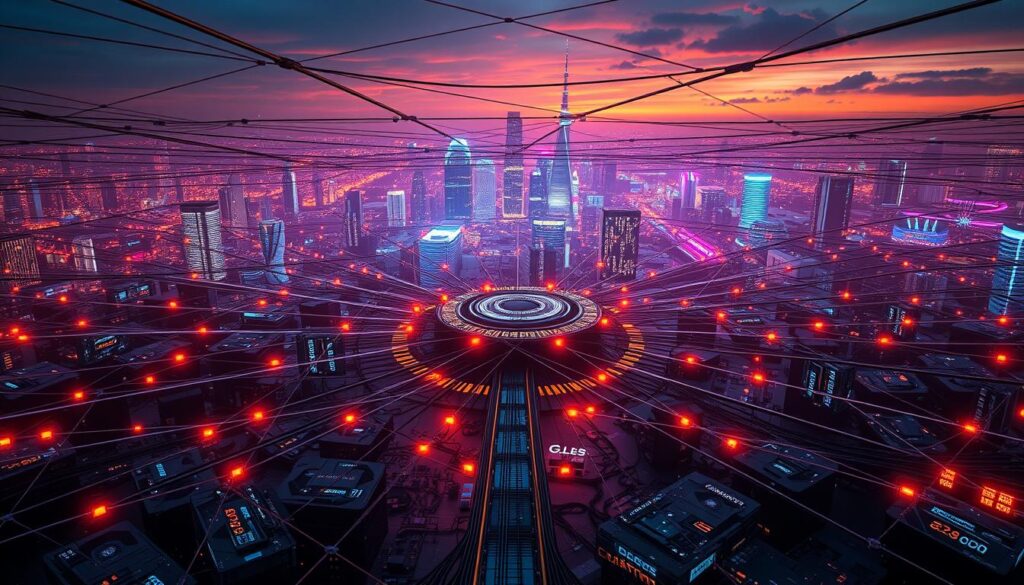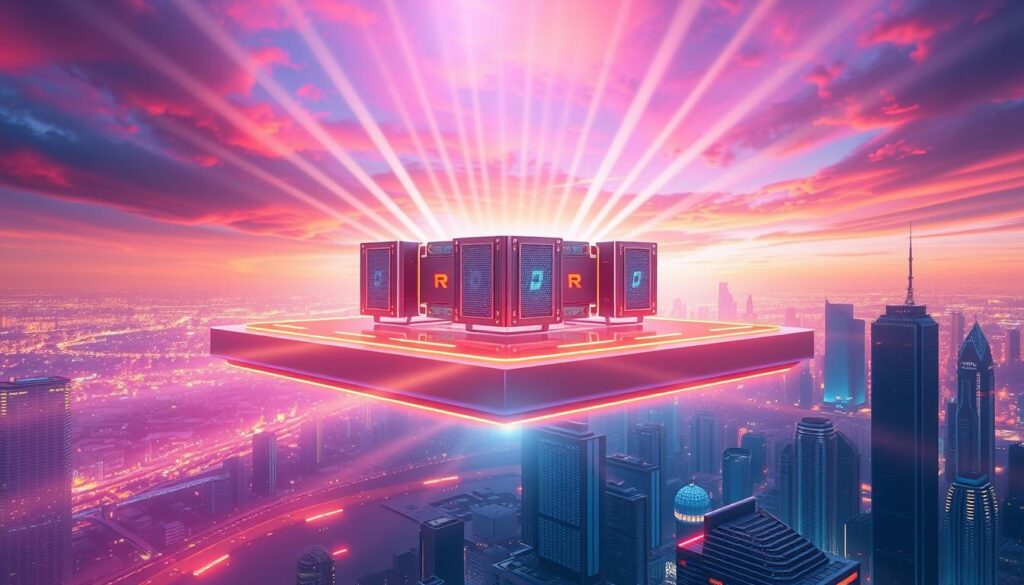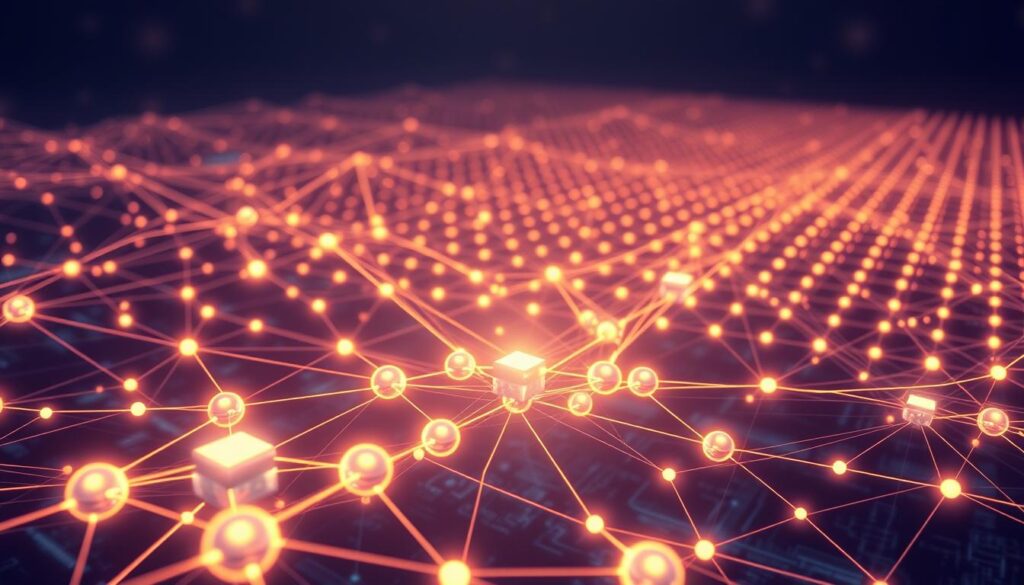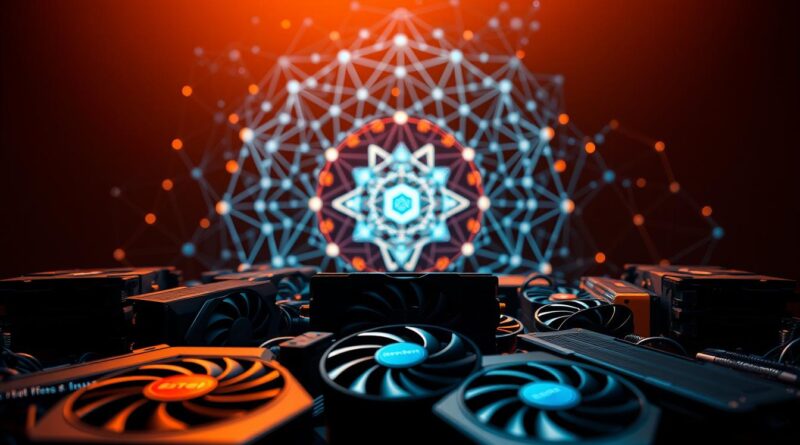Render (RNDR): The Game-Changing Decentralized Rendering Solution
Imagine a cryptocurrency token that rose over 30,000% in just seven years. That’s what happened with Render (RENDER), formerly RNDR). It went past its 2017 launch price by March 2024. Even as markets slowed, it stayed up 13,300% by August 2024. This is a remarkable achievement for a platform changing digital creation.
Render Network is a decentralized GPU marketplace. Users earn crypto by sharing their idle GPU power. The native RNDR token fuels transactions, making high-end visual effects affordable. This peer-to-peer system cuts down rendering time and costs, making it accessible to all.
Key Takeaways
- RENDER’s value exploded 30,000% by March 2024, retaining over 13,300% gains despite market dips.
- Render’s blockchain network uses idle GPUs globally, slashing rendering costs up to 90% for film, gaming, and AI projects.
- The RNDR token acts as both utility (paying for services) and governance (voting on upgrades like its Solana migration).
- Creators access Tiered pricing tiers—Trusted Partners to Economy—to match budget and speed needs, while node operators earn rewards for reliable performance.
- Founded in 2017, Render’s cross-chain infrastructure now spans 532 million circulating tokens, with community votes driving core decisions like protocol upgrades.
What is Render (RNDR) and How Does It Work?
Render Network is a decentralized blockchain render ecosystem. It lets users share idle GPU resources for 3D rendering projects. This render platform connects creators with providers of unused GPU capacity, all managed by smart contracts on Ethereum.
The Core Technology Behind Render Network
Render Network combines OTOY’s OctaneRender software with Ethereum’s blockchain. This mix makes a system where GPU providers earn RNDR tokens. Jobs use the ORbx format for real-time tracking of rendering progress.
How Decentralization Transforms Rendering Processes
Traditional rendering uses centralized servers. But, the render network spreads workloads across global devices. This brings big benefits:
- Cost savings: Up to 90% cheaper than cloud-based solutions
- Global GPU access: Uses underused hardware worldwide
- Flexible tiers: Users pick between Tier 2 (Priority) or Tier 3 (Economy), with Tier 1 (Trusted Partners) coming soon
The Role of OTOY in Developing Render
Founded in 2017 by CEO Jules Urbach, OTOY created OctaneRender for smoother visual effects creation. This knowledge powers Render Network’s core. OTOY aims to make high-end rendering accessible to everyone, not just big studios.
| Allocation | Percentage | Purpose |
|---|---|---|
| Public Sale | 25% | Funds raised during initial token sale |
| Reserve | 10% | Maintains token stability and liquidity |
| Escrow | 65% | Regulates supply/demand dynamics |
The Evolution of Digital Rendering: From Centralized to Decentralized

Old ways of digital rendering were stuck in the past, costing too much and limiting creativity. Render Network changed the game by using blockchain to spread out the power. Here’s how:
Traditional Rendering Challenges and Limitations
Old rendering farms needed a lot of resources. For example, making a 4K film could take days and cost a lot. Studios had trouble during busy times, and the servers used a lot of energy.
Small creators often couldn’t get to the best tools. This made it hard for them to be creative.
How Render Network Addresses Industry Pain Points
Render Network tackles these issues with three main points:
- Scalability: It uses global GPU nodes to grow with your project needs.
- Optionality: You can use resources with RNDR Credits (PayPal/Stripe), making it easier to start.
- IP Protection: Blockchain keeps your creative work safe while it’s being worked on.
The Burn and Mint Equilibrium (BME) keeps prices stable. A $30M investment from firms like Multicoin Capital in 2021 shows they believe in this vision.
The Technological Breakthrough of Distributed GPU Rendering
Render Network’s peer-to-peer setup uses many GPUs for better efficiency. Jobs are split and checked by nodes, all while being paid through blockchain. This is different from old systems:
| Feature | Traditional Systems | Render Network |
|---|---|---|
| Cost | Expensive server leases | Pay-per-use pricing |
| Speed | Limited by single hardware | 10-100x faster via GPU acceleration |
| Scalability | Fixed infrastructure limits growth | On-demand scaling via global nodes |
This change lets indie creators use high-end rendering, not just big studios. With Solana’s fast transactions, real-time rendering for the metaverse is now possible. The future looks bright, where creativity isn’t held back by cost or access.
RNDR Token: Powering the Render Ecosystem
The RNDR token is key to the Render Network, making it easy for creators and GPU providers to work together. It’s an ERC-20 token that powers a global marketplace. Here, unused computing power meets the high demand for 3D rendering, AR/VR, and AI.
- Fixed supply cap of 536.87 million tokens ensuring scarcity
- Three-tier distribution: 25% public sale, 10% reserve, 65% escrow for gradual release
- Dynamic pricing tied to job complexity and GPU provider performance
“Decentralized rendering requires a token economy that aligns incentives across global participants.”
The ecosystem got a big boost in late 2023. The network moved from Ethereum to Solana, introducing the $RENDER token. This change cut transaction fees by 95% and increased throughput to over 65,000 TPS.
Existing RNDR holders got a 1:1 airdrop of $RENDER tokens. This upgrade made the network faster and cheaper.
New features like RNDR Credits let users pay with PayPal or Stripe. This makes it easier for people to use blockchain services. Token holders also get rewards for helping keep the network safe. With a market cap over $4.27 billion as of March 2024, the RNDR coin is ready for the metaverse’s future needs.
Key Features and Benefits of the Render Platform

The Render platform is a game-changer for creators and businesses. It uses a decentralized system to make things more efficient. This means lower costs, better performance, and more security, all while being kinder to the planet.
Cost-Efficiency and Resource Optimization
Users can save up to 70% by using idle GPU power. The Render network offers pay-as-you-go pricing. This means no big upfront costs:
- Freelancers don’t have to buy expensive hardware
- Studios can grow without wasting money on unused resources
- People with extra GPUs can make money from them
Scalability and Performance Advantages
The Render platform is great for any project, big or small. It has a system that makes sure everything runs smoothly:
| Tier | OBh per RNDR Token | OBh per RNDR Credit |
|---|---|---|
| Tier 2 | 100 OBh | 400 OBh |
| Tier 3 | 200 OBh | 800 OBh |
Security Features and Network Reliability
The platform keeps your data safe with blockchain. It has strong security features:
- Every transaction is encrypted
- Nodes are checked for trustworthiness
- Jobs are assigned automatically to prevent fraud
65% of RNDR tokens are locked away for safety, ensuring a stable network for everyone.
Environmental Impact Compared to Traditional Solutions
Traditional rendering farms use a lot more energy than the Render network. By using distributed GPUs, it’s much greener. This helps meet global goals for sustainability without sacrificing quality.
Real-World Applications and Use Cases for Render Network
The Render Network is changing the game in many fields. It uses Render token for transactions. This lets artists, developers, and businesses use global GPU resources easily.
“Render Network’s distributed power made it possible to complete Westworld Season 4 opening titles in half the usual time.” — Raoul Marks, Creative Director
Many industries are using this technology:
- Film & Gaming: Marvel’s Captain Marvel and Ant-Man credits were made with Render. It also helped create realistic facial scans for movies.
- AI & Prototyping: AI developers have been using Render’s GPU network to train models and create visuals. This has cut costs by 40% compared to cloud services.
- Architecture: Companies like Foster + Partners use Render for 3D cityscapes and VR walkthroughs. This has reduced project timelines by 30%.
| Tier | Access Level | Use Case Examples |
|---|---|---|
| Tier 1 | Trusted partners | Hollywood VFX, AAA game studios |
| Tier 2 | High-quality rendering | Product prototyping, architectural visualization |
| Tier 3 | Economy option | Independent animators, small design teams |
Porsche uses Render to simulate car designs in real-time. Netflix and Warner Bros also use it for streaming content. In Q1 2023, over 2 million frames were processed, showing its power.
As the network grows, more brands will use Render token for tasks. This will make creativity and efficiency easier to achieve.
How to Participate in the Render Ecosystem

Join the Render Network’s decentralized rendering economy in three ways: GPU provider, content creator, or investor. Each role boosts the platform and offers special chances for rewards.
Becoming a Node Operator
Turn idle GPU power into cash by becoming a node operator. You need:
- High-end GPUs (NVIDIA RTX 3080 or similar)
- Stable internet and specific hardware
- Node Operator software installed
Earnings come in Render coin based on your GPU’s performance and job type. Those with high reputation scores get more jobs, earning more. The official Render site has guides and tutorials to help you start.
Using Render Services as a Content Creator
Here’s how content creators can use Render:
- Create and upload projects via the OctaneRender interface
- Set budgets in RNDR tokens, kept in escrow until the job is done
- Choose job levels and check progress on the dashboard
- Check the work to release Render coin payments to node operators
Escrow keeps things fair: payments are only made after approval, protecting both sides.
Investing in Render Coin
Investors can buy RNDR tokens on places like KuCoin or Gate.io. The Render coin has seen a huge increase, over 30,000%, by March 2024. It’s stayed strong even when markets change. Keep an eye on Render token sales and store your tokens safely with MetaMask. Remember, the coin’s value comes from its use in the network, but watch out for market ups and downs.
Render vs. Competitors: Comparative Analysis
Decentralized rendering solutions like Render compete with both old systems and new blockchain rivals. This analysis shows what makes them different in the market.
Render Network vs. Traditional Rendering Services
Old providers like AWS and Autodesk struggle with high costs and limits. Blockchain render platforms like Render offer 70% lower costs. They use decentralized GPU networks.
Render has seen a big jump in efficiency. It processed 58% more frames in 2021 than the year before.
- Cost: 30% cheaper than cloud services
- Speed: Rendered 9.42 million frames in 2022, up from 5.95 million in 2021
- Eco-friendliness: Uses 40% less energy than traditional farms
“Decentralized networks reduce creative bottlenecks while slashing operational costs by 60%+.” – Tech Analyst Report
How Render Stacks Up Against Blockchain Rivals
Competitors like FRT and WLD don’t have Render’s level of enterprise-grade infrastructure. Render’s Solana-based architecture can process 4080 transactions per second. That’s 290 times faster than Ethereum.
Its dual-layer system balances security and speed. Rivals like FRT face high fees and slow scaling.
- Performance: 4080 TPS vs Ethereum’s 14
- Adoption: Powers NASA projects and Hollywood films
- Ecosystem: Integrates with OTOY’s OctaneRender engine
Render’s price has seen some ups and downs, dropping by -5.32% in 2024. But its 300% increase in 2023 shows it’s gaining traction. Its $3B market cap and 68% token circulation put it ahead of niche competitors like FET (-4.23% decline).
The Future Roadmap and Vision for Render
Render Network is moving forward with new upgrades and partnerships. Phase I ended in March 2024, finishing key integrations like ORC’s link to the Render network. Now, Phase II aims to grow to millions of users and add more AI tools.
Jules Urbach talked about using Apple’s GPU, saying it could beat cloud costs. “Tapping into 120GB GPU resources in consumer devices could outperform centralized cloud costs,” he said.
“Decentralized approaches solve cloud scalability bottlenecks,” said Urbach, highlighting Solana’s adoption post-community vote. The switch reduces transaction fees by 90%, enabling faster Render token transactions for global nodes.
Upcoming milestones include:
- Alpha testing of peer-to-peer rendering on testnets by Q2 2024
- Mainnet beta access for Genesis token sale participants
- Nvidia GTC 2024 presentation on March 18, unveiling AI-3D workflow tools
| Phase | Key Goals |
|---|---|
| Phase I (Completed) | ORC integration, token reconciliation |
| Phase II | Mass adoption, AI rendering tools, Solana optimization |
Render Network is teaming up with GPU leaders like Nvidia. They aim to make OpenUSD standard for AI 3D assets. Render Network wants to make high-end rendering more accessible with generative AI.
Urbach said using Apple’s GPUs could save 70% over AWS. These steps make the Render token important in the AI-rendering world.
Conclusion: Why Render (RNDR) Matters in the Digital Content Revolution
Render Network is changing how digital content creators get access to powerful computing. It uses a decentralized GPU-sharing model. This makes high-end tools available to artists and developers all over the world.
The RNDR coin makes transactions easy. It powers everything from VR projects to scientific simulations. This shows how important Render Network is in the digital content world.
Recent numbers show its impact: over 9.4 million frames rendered in 2022. There was a 58% annual increase. Node operators get payouts every 7–10 days, and users choose based on their project needs.
The upcoming “Trusted” tier and AI integration will make things even better. This will help with the growing need for computational power in tech.
Render Network stands out because it focuses on AR/VR workloads. Its Burn-and-Mint Equilibrium model helps keep the RNDR coin value stable. Advisors like Beeple and J.J. Abrams add credibility to the project.
As digital content demands grow, Render is leading the way. The RNDR coin’s 400% surge in early 2023 shows market confidence. Ongoing SDK improvements and partnerships like Octane X’s Mac integration are expanding its user base.
Render Network is making it easier for creators, engineers, and businesses to access powerful tools. This makes cutting-edge tech more accessible without high costs.




